
sabrigade
-
Posts
1,707 -
Joined
-
Last visited
-
Days Won
34
Content Type
Profiles
Forums
Blogs
Gallery
Events
Store
Posts posted by sabrigade
-
-
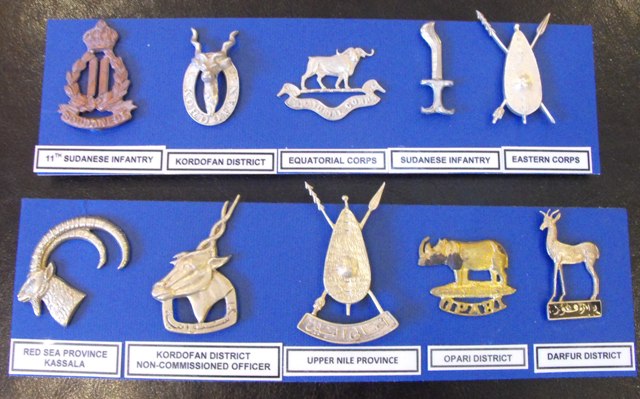
Any comments on the descriptions would be very welcome.
0 -

Variations of the S.D.F. badge.
0 -
Thanks Mervyn,
I have been researching the early police units for a while now and have built up a good data base and library.
Thanks for deleting the double posting!
Regards,
Will
0 -
http://gmic.co.uk/uploads/monthly_05_2011/post-3034-0-06204400-1305542878.jpghttp://gmic.co.uk/uploads/monthly_05_2011/post-3034-0-29633100-1305542881.jpg
Naming on double issue.
0 -

Double issue to Mundell.
0 -
http://gmic.co.uk/uploads/monthly_05_2011/post-3034-0-83191200-1305542243.jpghttp://gmic.co.uk/uploads/monthly_05_2011/post-3034-0-28395500-1305542248.jpg
A scarce pair named to the East London Company of the Essential Protection Corps.
120 members were entitled to this award but only 14 medals were claimed with the EL prefix.
The Corps was formed on 25 October 1939 and was for men over 45 years of age.
The purpose of the Corps was to protect key installations and its members qualified for the award of the Africa Service Medal.
Mundell was awarded a rare double issue of these tow campaign medals.
0 -
http://gmic.co.uk/uploads/monthly_05_2011/post-3034-0-66824200-1305542055.jpghttp://gmic.co.uk/uploads/monthly_05_2011/post-3034-0-49919500-1305542058.jpg
The Allied Victory Medal, 1914-18.
0 -
http://gmic.co.uk/uploads/monthly_05_2011/post-3034-0-10367500-1305541863.jpghttp://gmic.co.uk/uploads/monthly_05_2011/post-3034-0-91125500-1305541866.jpg
British War Medal to Hartigan's Horse.
0 -

As a member of the Essential Service Protection Corps in East London, South Africa during World War 2.
On his right breast, Mundell is wearing the ribbons of the campaign medals that were awarded to his father for service during the 1879 Anglo-Zulu War and the Anglo-Boer War of 1899 to 1902.
0 -

Proof of receipt
0 -
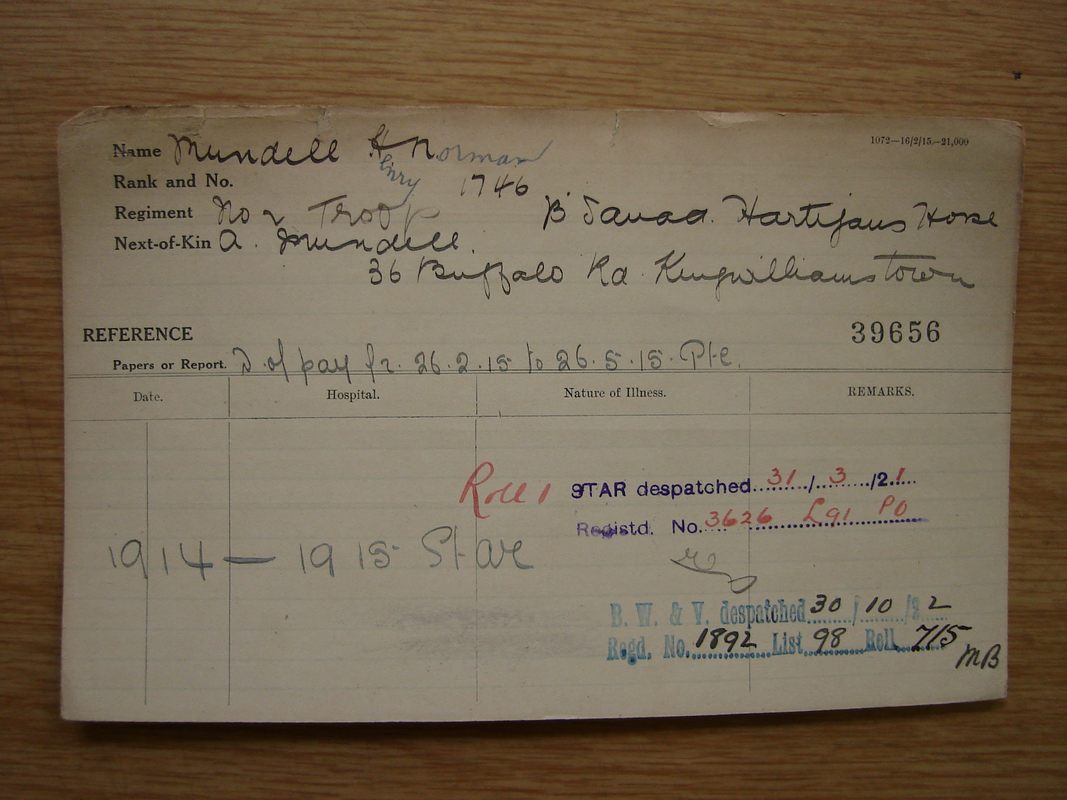
Mundell's World War One card.
0 -
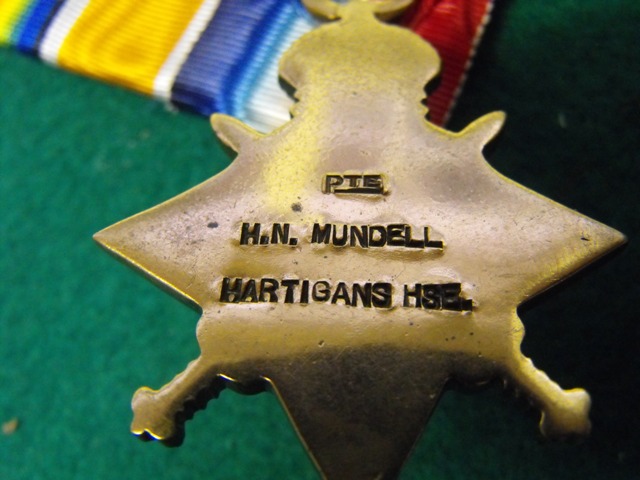
1914-15 Star to Hartigan's Horse
0 -
w
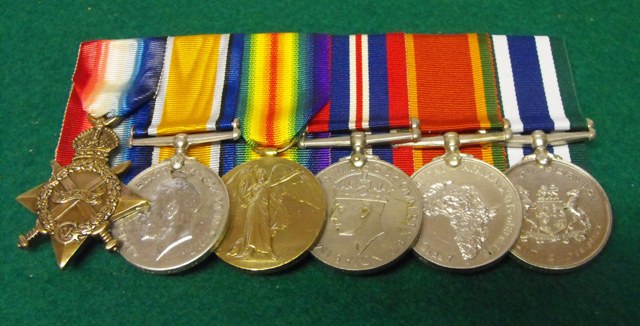
MUNDELL'S MEDAL GROUP
The medal group includes:
1. The 1914-1915 Star.
2. British War Medal (1914 to 1920).
3. Allied Victory Medal, 1914 to 1918.
4. The War Medal (3rd September 1939 to 2nd September 1945).
5. The Africa Service Medal.
6. South African Police Long Service and Good Conduct Medal.
0 -
HARTIGAN'S HORSE
Prior to joining Hartigan's Horse, No 1746(M) Constable H.N.Mundell served in the South African Police District No 21 in the town of Middelburg in the Eastern Cape. This District was part of the Eastern CapeDivision. Born on 19 March 1891, Mundell attested in the Cape Mounted Police in 1909 and then joined the South African Police on its establishment. He would retire in 1936 after 27 years' service.
Hartigan's Horse was raised, equipped and trained for operational service within a period of two weeks. A serving member and officer of the SouthAfrican Police, Lieutenant Colonel Hartigan, was authorised by the Minister of Defence of the Union of South Africa to raise a unit to serve in the German South West African campaign. Hartigan was the Acting Deputy Commissioner of Police in the Eastern Division of the Cape Province.
Headquarters were established in East London in December,1914 and the unit was already at full strength by the end of January, 1915.More than 100 potential recruits had to be turned away. Four squadrons were then formed.
"A" Squadron was formed with members of the Southern Rifles and they were from the territories that formed the Transkei.
"B" Squadron was initially formed from a nucleus of men from the Eastern Division of the South African Police. Mundell joined this Squadron and was posted to "B" Troop. Like all South African Policemen who joined the Regiment, he was attached to the Union Defence Force "for service in the field" from 17 January 1915.
"C' Squadron was formed from the Transkei Mounted Rifles.
"D" Squadron consisted of new recruits and their training was conducted by members from the South African Police.
The Regiment had many experienced military and police veterans which were conducive to their quick preparation and training. These elite included men from the England,Scotland, Ireland, Wales, South Africa, Australia and even Denmark.
The Regiment had the reputation of being one of the finest "fighting" regiments that was established for the German South West Africa campaign. With very few exceptions, all the members of the South African Police returned to their police duties with effect from 31 May 1915. Mundell's date on his World War One card states he left the U.D.F. on 26 May 1915.
0 -
Thanks Gavin,
I have all my medals mounted and "cleaned" by a proffessional for display as I find that it is the best way to preserve and care for the collection.
This is a fascinating period of history.
Regards,
Will
0 -
Hi Gavin,
The Gordon Star is in many ways a unique award and is very interesting.
There are many questions regarding its issue and history that have not and may never be answered.
The awards were apparently sand cast by a well known Khartoum jeweler. It has also been said that the awards were cast from General Gordon's Turkish Order of the Mejidieh.This fact has not been confirmed.
It would appear as if the Order used was for the Crimean War period during which General Gordon was an active participant as a junior Sapper officer. He was awarded the Turkish Order for his Crimean service.
The star has the words in Arabic for "The Siege of Khartoum" and the date of 1301 which is theHegira year for the year of the siege, 1884.
As far as it has been ascertained, the awards were given in three categories:
Silver gilt. These were awarded to senior military officers, senior government officials and senior civilian inhabitants of Khartoum. According to the Medal Yearbook, some recipients had to purchase their medals and the proceeds went into a fund to feed the poor. A very good example is in the Khalifa's House Museum in Omdurman.
Silver. Awarded to junior officers.
Pewter. This version was awarded to the junior members of Gordon's garrisson and was also given to female servants and scholars in Khartoum. This is by far the more common version and I have three examples in my collection which I have sourced in the Sudan.
There are some more knowledgable members on the Forum who may be able to add more details.
Regards,
Will
0 -
http://gmic.co.uk/uploads/monthly_05_2011/post-3034-0-16422000-1304760494.jpghttp://gmic.co.uk/uploads/monthly_05_2011/post-3034-0-39071600-1304760496.jpg
0 -

The star after it has been mounted.
The ribbon was given to me by a member of this Forum who has done a major amount of research on this medal.
In his opinion, the original ribbon was half inch wide red braid that was found on contemporary Egyptian military uniforms.
1 -
Hey Will...
Dont your fingernails get in the way of digging out landmines??
Hey Chris,
Will tell the wife, she will be impressed!
Wil PM you.
Regards,
Will
0 -
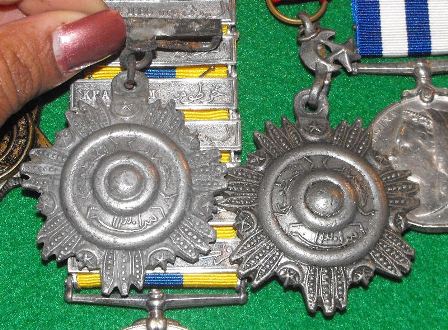
Two of the stars in my collection. The difference is very apparent.
1 -
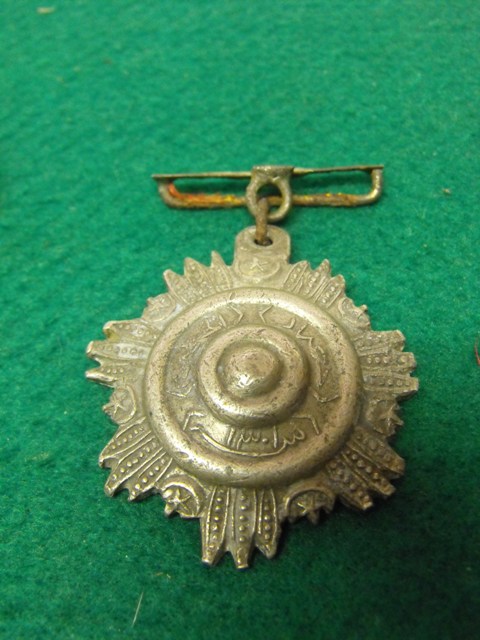
This is a recent addition to my collection and I purchased it from one of my sources in the Sudan.
It is not suspended by a ring from a crescent and star which is the usually accepted method.
The "rust' in the suspension bar is actually threads from the original crimson ribbon.
1 -
Without sounding negative, maybe we should keep the focus on Owen's amazing group?
I also do not like to discuss prices on the forum as they then seem to set the standard for "informal" auctions and we are then played off against each other.
I am very interested in the background of the recipient, Owain please keep us posted.
0 -
Hi Owain,
An excellent and very unique addition, has great potential for one of your articles!
Regards,
Will
0 -
Brett,
Thank you for the very informative post.
His service card states that he was involved in policing duties in Natal when the German South West Africa campaign took place.
I find these early police groups fascinating and will request more research.
Is there any chance of locating his picture in the magazine?
Regards,
Will
0


The Endley Collection : Part 2 : World War One
in Great Britain: Empire: Colonial Including South Africa & India: Awards, Militaria & History
Posted
I spent a few days at home and have had time to add and work on my displays.